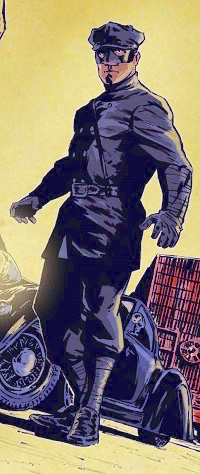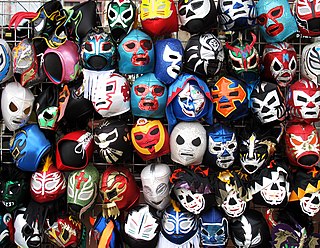See also
- "The Girl in the Blue Mask", episode of Criminal Minds: Suspect Behavior
The Blue Mask is a 1982 album by singer-songwriter Lou Reed.
The Blue Mask may also refer to:

The Legend of Zelda: Majora's Mask is a 2000 action-adventure game developed and published by Nintendo for the Nintendo 64. It was the second The Legend of Zelda game to use 3D graphics, following Ocarina of Time (1998). Designed by a creative team led by Eiji Aonuma, Yoshiaki Koizumi, and Shigeru Miyamoto, Majora's Mask was completed in less than two years. It featured enhanced graphics and several gameplay changes, but reused a number of elements and character models, which the game's creators called a creative decision made necessary by time constraints.

Richard Bartlett Schroder is an American actor and filmmaker. As a child actor billed as Ricky Schroder he debuted in the film The Champ (1979), for which he became the youngest Golden Globe award recipient, and went on to become a child star on the sitcom Silver Spoons (1982–87). He has continued acting as an adult, usually billed as Rick Schroder, notably in the Western miniseries Lonesome Dove (1989) and on the police drama series NYPD Blue (1998–2001). He made his directorial debut with the film Black Cloud (2004) and has produced several films and television series including the anthology film Locker 13 and the war documentary The Fighting Season.

A diving mask is an item of diving equipment that allows underwater divers, including scuba divers, free-divers, and snorkelers, to see clearly underwater. Surface supplied divers usually use a full face mask or diving helmet, but in some systems the half mask may be used. When the human eye is in direct contact with water as opposed to air, its normal environment, light entering the eye is refracted by a different angle and the eye is unable to focus the light on the retina. By providing an air space in front of the eyes, the eye is able to focus nearly normally. The shape of the air space in the mask slightly affects the ability to focus. Corrective lenses can be fitted to the inside surface of the viewport or contact lenses may be worn inside the mask to allow normal vision for people with focusing defects.

An oni is a kind of yōkai, demon, orc, ogre, or troll in Japanese folklore. They are believed to live in caves or deep in the mountains. Oni are known for their superhuman strength and have been associated with powers like thunder and lightning, along with their evil nature manifesting in their propensity for murder and cannibalism. They are typically portrayed as hulking figures with one or more horns growing out of their heads, massive teeth, and occasionally a third eye in the center of the forehead. They are typically depicted with red, blue, black, or yellow colored skin, wearing loincloths of tiger pelt, and carrying iron kanabō clubs. They also have three to six digits on each hand and foot tipped with claw-like nails. Oni are able to change their looks to fool their victims into trusting them. Oni can be male or female, but have been predominantly male throughout history. Female oni are sometimes referred to by the name Yamauba. When in disguise, oni are capable of appearing as a man or woman, regardless of their gender. As monstrous as oni are, they have been linked to bringing good fortune and wealth.

Kato is a fictional character from The Green Hornet franchise. This character has appeared with the Green Hornet in radio, film, television, book and comic book versions. Kato is the Hornet's assistant and has been played by a number of actors. On radio, Kato was initially played by Raymond Hayashi, then Roland Parker who had the role for most of the run, and in the later years Mickey Tolan and Paul Carnegie. Keye Luke took the role in the movie serials, and in the television series, he was portrayed by Bruce Lee. Jay Chou played Kato in the 2011 Green Hornet film.

A wrestling mask is a fabric-based mask that some professional wrestlers wear as part of their in-ring persona or gimmick. Professional wrestlers have been using masks as far back as 1915 and they are still widely used today, especially in Lucha Libre in Mexico.

Lucha libre is the term for the style of professional wrestling originating in Mexico. Since its introduction to Mexico in the early 20th century, it has developed into a unique form of the genre, characterized by colorful masks, rapid sequences of holds and maneuvers, and "high-flying" maneuvers, some of which have been adopted in the United States, Japan, and elsewhere. The wearing of masks has developed special significance, and matches are sometimes contested in which the loser must permanently remove his mask, which is a wager with a high degree of weight attached. Tag team wrestling is especially prevalent in lucha libre, particularly matches with three-member teams, called trios.

The Blue Mask is the eleventh solo studio album by American rock musician Lou Reed, released on February 23, 1982, by RCA Records. Reed had returned to the label after having left Arista Records. The album was released around Reed's 40th birthday, and covers topics of marriage and settling down, alongside themes of violence, paranoia, and alcoholism.

Alejandro Muñoz Moreno, better known by the ring name Blue Demon, was a Mexican film actor and luchador enmascarado. Blue Demon is considered a legend of lucha libre, partially from starring in a series of Lucha films between 1961 and 1979, often alongside in-ring rival El Santo. His in-ring career began in 1948 and stretched for 41 years until his retirement in 1989.
Camouflage is a method of avoiding detection by mimicking the surrounding environment.

Underwater vision is the ability to see objects underwater, and this is significantly affected by several factors. Underwater, objects are less visible because of lower levels of natural illumination caused by rapid attenuation of light with distance passed through the water. They are also blurred by scattering of light between the object and the viewer, also resulting in lower contrast. These effects vary with wavelength of the light, and color and turbidity of the water. The vertebrate eye is usually either optimised for underwater vision or air vision, as is the case in the human eye. The visual acuity of the air-optimised eye is severely adversely affected by the difference in refractive index between air and water when immersed in direct contact. Provision of an airspace between the cornea and the water can compensate, but has the side effect of scale and distance distortion. The diver learns to compensate for these distortions. Artificial illumination is effective to improve illumination at short range.
Face mask may refer to:
The Mask may refer to:

Congenital sensorineural deafness occurs commonly in domestic cats with a white coat. It is a congenital deafness caused by a degeneration of the inner ear. Deafness is far more common in white cats than in those with other coat colours. According to the ASPCA Complete Guide to Cats, "17 to 20 percent of white cats with nonblue eyes are deaf; 40 percent of "odd-eyed" white cats with one blue eye are deaf; and 65 to 85 percent of blue-eyed white cats are deaf."

A melanistic mask is a dog coat pattern that gives the appearance of a mask on the dog's face. The hairs on the muzzle, and sometimes entire face or ears, are colored by eumelanin instead of pheomelanin pigment. Eumelanin is typically black, but may instead be brown, dark gray, or light gray-brown. Pheomelanin ranges in color from pale cream to mahogany. The trait is caused by M264V (EM), a completely dominant allele (form) of the melanocortin 1 receptor gene.

The Slow Mo Guys is a science and technology entertainment web series from Thame, England, created by Gavin Free, starring himself and Daniel Gruchy. It has been described as the biggest channel for slow motion videos on YouTube.

PJ Masks is a computer-animated superhero children's television series based on the Les Pyjamasques book series by Romuald Racioppo. Produced by Frog Box, Hasbro Entertainment, Walt Disney EMEA Productions Limited and TeamTO, its production has the participation of France Télévisions and Disney Junior. The series is broadcast worldwide on Disney Branded Television's Disney Junior channels; in its home country of France, it airs on France 5.
Mask in Blue may refer to:

The wearing of non-medical face masks in public to lessen the transmission of COVID-19 in the United States was first recommended by the CDC on April 3, 2020, as supplemental to hygiene and appropriate social distancing. Throughout the pandemic, various states, counties, and municipalities have issued health orders requiring the wearing of non-medical face coverings — such as cloth masks — in spaces and businesses accessible to the public, especially when physical distancing is not possible.

During pandemics, some people have opposed requirements by governments and private establishments to wear face masks as a public health measure against disease. Such rules typically follow recommendations of health experts to reduce the spread of disease through such non-pharmaceutical interventions.